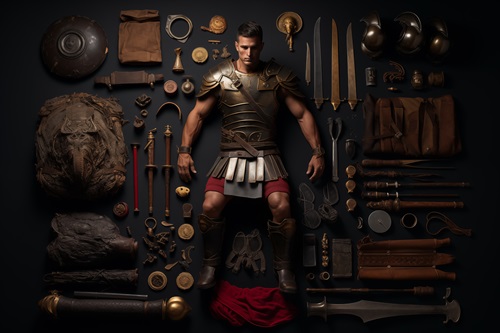In the grand amphitheaters of ancient Rome, gladiators were the embodiment of valor and combat prowess. These fierce warriors captured the imaginations of countless spectators, with their battles transcending mere sport and evolving into a symbol of the Roman Empire's power and culture. Today, we delve into the art of knolling, a meticulous arrangement of objects, to portray a Roman gladiator standing amidst his attire. In this intricate tableau, we shall explore not just the visual elements but also the profound significance of the gladiator's role in Roman society.
I. The Knolling Arrangement
Before us stands a representation of a Roman gladiator, meticulously arranged in a knolling tableau. At the center of this display is our gladiator, a muscular and statuesque figure, embodying strength and courage. He is adorned in his distinctive armor, meticulously laid out around him in a deliberate manner.
-
The Gladiator: Our gladiator stands upright, with his feet slightly apart, conveying an aura of readiness for combat. His body is adorned with a finely detailed breastplate, fashioned from gleaming metal and decorated with intricate patterns, signifying both protection and status.
-
The Helmet: Beside the gladiator lies his iconic helmet, known as the "galea." It is a testament to his identity and anonymity in battle, covering his face with a menacing visor, which he would lower when stepping into the arena.
-
The Gladius: A short sword, known as the "gladius," rests at his side. This weapon was his loyal companion, a symbol of his skill and the instrument of his fate.
-
The Scutum: Behind the gladiator, his rectangular shield, the "scutum," leans against the wall. It bears the scars of numerous battles, each dent telling a tale of survival and skill.
-
The Sandals: The gladiator's footwear, leather sandals or "caligae," lies neatly positioned near his feet. These humble yet essential pieces were his only contact with the arena's unforgiving sands.
-
The Arena: The knolling tableau is set against a backdrop reminiscent of the arena's walls, which bore witness to countless spectacles of combat and drama.
II.The Gladiator's Role
Now that we have established the meticulous arrangement, we delve into the deeper significance of the gladiator's role in ancient Roman society.
-
Entertainment and Spectacle: Gladiatorial combat was more than just a sport; it was a spectacle that captivated the hearts of Roman citizens. These battles provided a source of entertainment, offering an escape from the rigors of daily life.
-
Symbol of Roman Virtue: Gladiators were seen as embodying the core Roman virtues of courage, discipline, and endurance. Their willingness to face death in the arena was celebrated as the ultimate test of these virtues.
-
Social Status and Freedom: While many gladiators were slaves or prisoners of war, some volunteered for this life in the hopes of achieving fame and fortune. In rare cases, a gladiator could earn his freedom through his valorous deeds in the arena.
-
Political Tool: Emperors and politicians often used gladiatorial games as a means of gaining favor with the public. Hosting lavish spectacles with skilled gladiators could bolster their popularity and authority.
-
Cultural Influence: The image of the gladiator has left an indelible mark on art, literature, and even modern popular culture. Their stories of struggle and survival continue to inspire and captivate audiences worldwide.
In conclusion, the knolling arrangement of a Roman gladiator standing amidst his attire serves as a poignant reminder of the rich history and cultural significance of these ancient warriors. Beyond the meticulous arrangement of objects, it symbolizes the enduring legacy of gladiators in Roman society—a testament to their bravery, endurance, and the complex interplay of entertainment, politics, and cultural influence in the ancient world.


